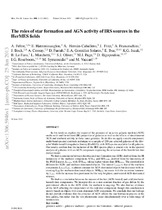| dc.contributor.author | Feltre, Anna | |
| dc.contributor.author | Hatziminaoglou, Evanthia | |
| dc.contributor.author | Vaccari, Mattia | |
| dc.contributor.author | Hernán-Caballero, Antonio | |
| dc.contributor.author | Fritz, Jacopo | |
| dc.contributor.author | Franceschini, Alberto | |
| dc.contributor.author | Bock, J. | |
| dc.contributor.author | Cooray, Asantha | |
| dc.contributor.author | Farrah, Duncan | |
| dc.contributor.author | Gonzalez-Solares, Eduardo A. | |
| dc.contributor.author | Ibar, Edo | |
| dc.contributor.author | Isaak, Kate G. | |
| dc.contributor.author | Lo Faro, Barbara | |
| dc.contributor.author | Marchetti, L. | |
| dc.contributor.author | Oliver, Seb J. | |
| dc.contributor.author | Page, Matthew J. | |
| dc.contributor.author | Rigopoulou, Dimitra | |
| dc.contributor.author | Roseboom, Isaac G. | |
| dc.contributor.author | Symeonidis, Myrto | |
| dc.date.accessioned | 2017-07-13T14:08:40Z | |
| dc.date.available | 2017-07-13T14:08:40Z | |
| dc.date.issued | 2013 | |
| dc.identifier.citation | Feltre, A. et al. (2013). The roles of star formation and AGN activity of IRS sources in the HerMES fields. Monthly Notices of the Royal Astronomical Society, 434 (3): 2426-2437 | en_US |
| dc.identifier.issn | 0035-8711 | |
| dc.identifier.uri | http://hdl.handle.net/10566/3075 | |
| dc.description.abstract | In this work we explore the impact of the presence of an active galactic nucleus (AGN)
on the mid- and far-infrared (IR) properties of galaxies as well as the effects of simultaneous
AGN and starburst activity in these same galaxies. To do this we apply a multi-component,
multi-band spectral synthesis technique to a sample of 250 μm selected galaxies of the HerschelMulti-
tiered Extragalactic Survey (HerMES), with IRS spectra available for all galaxies.
Our results confirm that the inclusion of the IRS spectra plays a crucial role in the spectral
analysis of galaxies with an AGN component improving the selection of the best-fit hot dust
(torus) model.
We find a correlation between the obscured star formation rate (SFR) derived from the IR
luminosity of the starburst component, SFRIR and SFRPAH, derived from the luminosity of
the PAH features, LPAH, with SFRFIR taking higher values than SFRPAH. The correlation is
different for AGN- and starburst-dominated objects. The ratio of LPAH to that of the starburst
component, LPAH/LSB, is almost constant for AGN-dominated objects but decreases with increasing
LSB for starburst-dominated objects. SFRFIR increases with the accretion luminosity,
Lacc, with the increase less prominent for the very brightest, unobscured AGN-dominated
sources.
We find no correlation between the masses of the hot (AGN-heated) and cold (starburstheated)
dust components. We interpret this as a non-constant fraction of gas driven by the
gravitational effects to the AGN while the starburst is ongoing. We also find no evidence
of the AGN affecting the temperature of the cold dust component, though this conclusion is
mostly based on objects with a non-dominantAGN component.We conclude that our findings
do not provide evidence that the presence of AGN affects the star formation process in the
host galaxy, but rather that the two phenomena occur simultaneously over a wide range of
luminosities. | en_US |
| dc.language.iso | en | en_US |
| dc.publisher | Oxford University Press | en_US |
| dc.rights | Publisher retains copyright. Authors may archive the published version in their institutional repository. | |
| dc.source.uri | https://dx.doi.org/10.1093/mnras/stt1177 | |
| dc.subject | Galaxies | en_US |
| dc.subject | Active - galaxies | en_US |
| dc.subject | Starburst – galaxies | en_US |
| dc.subject | Star formation – infrared | en_US |
| dc.title | The roles of star formation and AGN activity of IRS sources in the HerMES fields | en_US |
| dc.type | Article | en_US |
| dc.description.accreditation | Department of HE and Training approved list | |

